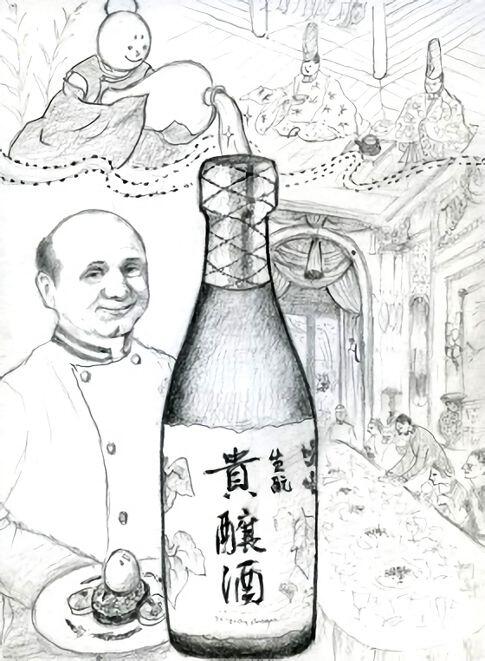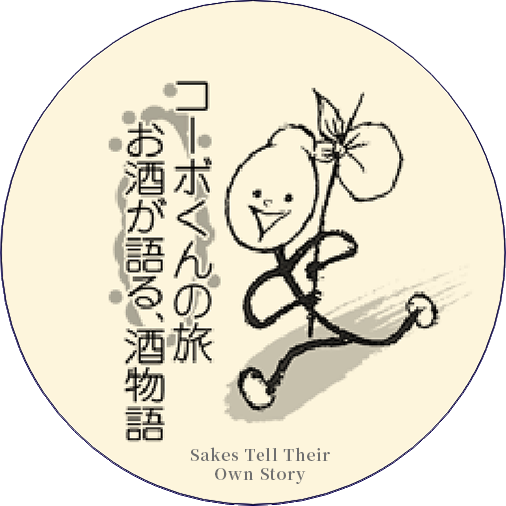| Yeast |
“Today I’m going to talk to Kimoto Kijoshu, who should soon be here.” |
|
 |
| Kijoshu |
“Yeast, I’ve kept you waiting.” |
| Yeast |
“It doesn’t matter. Please tell me first what kijoshu is.” |
| Kijoshu |
“A good question. Kijoshu is brewed by replacing part of the brewing water by sake. Because of the sluggish fermentation, this results in a rich, sweet taste. Such a type of sake seems already to have been brewed in the imperial palace in the Heian period (894-1185).” |
| Yeast |
“Sake made with sake! How extravagant! Does the method for making kijoshu already exist from long ago?” |
| Kijoshu |
“The method was developed 70 years ago by researchers who wondered if they could make a sake resembling the sweet and rich botrytized wines of France. But in reality the same method seems to have existed in Japan in ancient times.” |
| Yeast |
“When did Daishichi start making this?” |
| Kijoshu |
“In 2001. We have been making it every year since then. We also made some interesting discoveries, typical for Daishichi.” |
| Yeast |
“What was that?” |
| Kijoshu |
“First, that the vigorous kimoto yeast doesn’t become gentle or sluggish, but continues driving a powerful fermentation.” |
| Yeast |
“That must be why Daishichi’s kijoshu is not sugary, but has a clear structure and smooth finish! I also love the complex acidity of Kimoto Kijoshu.” |
| Kijoshu |
“That is thanks to the yeast. One other surprise: it was difficult to determine when the taste of our kijoshu would be at its best.” |
| Yeast |
“You mean it could get even more delicious after many years passed?” |
| Kijoshu |
“Indeed. We brought out vintage 2001 in 2007. We now age it even longer, for more than 10 years. There is no end to its potential.” |
| Yeast |
“That’s the hidden power of the kimoto method!” |
| Kijoshu |
“Right. The sweet sake is enlivened by kimoto’s noble acidity. That is the pillar of its good balance and the driving force behind its maturation.” |
| Yeast |
“Could you also tell me about the label design?” |
| Kijoshu |
“Its motif is Daishichi’s traditional ivy leaf. In my case, it’s a really big leaf.” |
| Yeast |
“The green of the leaf harmonizes nicely with the dark green color of the bottle. With what dishes can you be paired?” |
| Kijoshu |
“As an after dinner dessert wine, I naturally fit to blue cheese, dry fruits like figs and to chocolate. But it is also fun to pair me with main dishes as sauté of foie gras or simmered game meat. |
| Yeast |
“Eric Briffard, the Executive Chef of top hotel Georges Cinq in Paris once made a pairing with a foie gras dish that used a sauce of pears. Only the thought of it makes my mouth water!” |
| Kijoshu |
“That was really special. My serving temperature is slightly chilled, but not too cold. Drink me from a large glass, so that my rich fragrance can develop and you can enjoy the aroma as well.” |
| Yeast |
“I understand! How many bottles are produced every year?” |
| Kijoshu |
“Only a few hundred 300ml bottles. It is difficult to control the fermentation, so we can’t produce it in large quantities.” |
| Yeast |
“That makes you a precious little bottle! The amount is small, but Kimoto Kijoshu is a jewel in the crown of Daishichi’s way if thinking!” |





